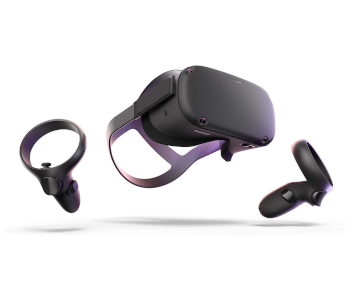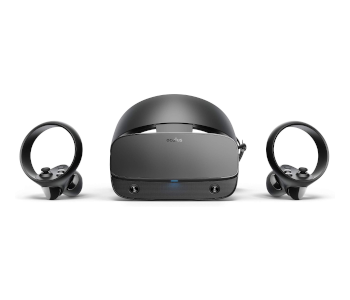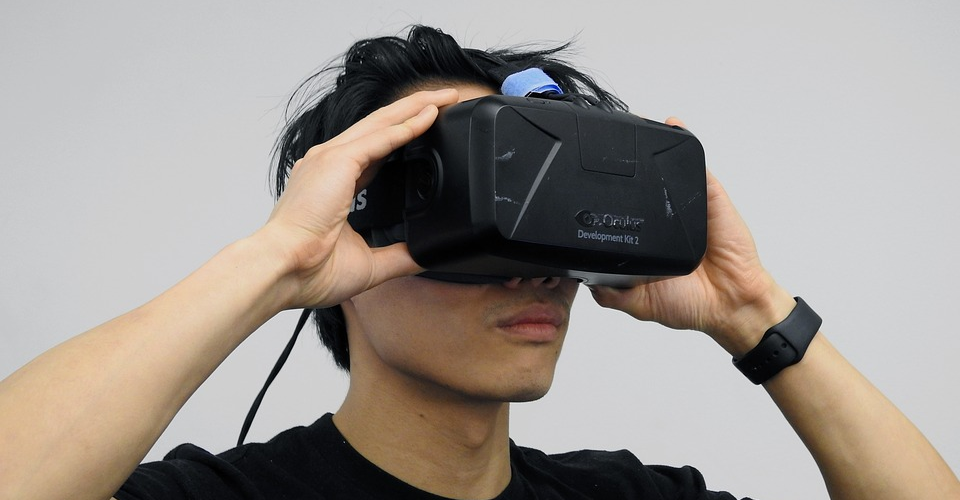How Does the Oculus Quest Link Compare to the Oculus Rift S?
The Oculus brand has been around way before VR headsets have enjoyed the level of popularity they are enjoying today. One of the industry pioneers, the acquisition of Oculus by Facebook has helped them maintain a healthy presence in a market that has now become much more competitive.
The strength of the brand, aside from their excellent VR content, has always been their consumer-friendly VR headsets. Their headsets, particularly the recent Oculus Quest and Oculus Rift S, deliver a satisfying VR experience but are priced just low enough to entice casual users.
More recently, Oculus announced an upcoming update to the Quest. Called Oculus Link, many experts have weighed in on how this upgrade will render the Oculus Rift S obsolete in favor of the Quest. Is there weight behind these affirmations? Check out our take below
Oculus Quest vs. Oculus Rift S
The Oculus Quest and Oculus Rift S were both launched this year with exactly the same price tags, making them perfect points of comparison. Each of the two VR headsets had enough distinct features to appeal to different types of users. Where the Quest provided unique portability, the Rift S had the advantage of hooking up with the superior hardware of a gaming PC.
We’ve already published a detailed comparison of the two headsets, which you may check out here. If you want the condensed version, here’s a quick summary of what sets the Oculus Quest and the Oculus Rift S apart.
| Parameter | Oculus Quest | Oculus Rift S |
|---|---|---|
| Type | Wireless standalone | PC-based, tethered |
| Display type | Pentile OLED | LCD |
| Display resolution | 2880 x 1660 | 2560 x 1440 |
| Refresh rate | 72 Hz | 80 Hz |
| Graphics processor | Snapdragon 835 | Depends on PC |
| Content library | Android-based Quest store | PC-based Oculus Rift store |
| Straps | Standard T-shaped strap | Adjustable halo and strap |
| Passthrough | Monoscopic | Stereoscopic (Passthrough+) |
Outside of this list of major differences, the Oculus Quest and the Rift S share a lot of the same characteristics. They both come with a pair of Oculus Touch handheld controllers, are equipped with sensors that allow six degrees of freedom, and have integrated audio (with the option to for external AUX output).
Oculus Quest benefits from its standalone appeal, allowing users to enjoy a satisfying VR experience without having to depend on a powerful PC. Of course, there are a couple of limitations inherent to it being a portable device – a less powerful graphics processor, limited storage, and limited battery life.
One major consequence of the limited hardware integrated with the Oculus Quest is that it must also be limited to less resource-intensive VR experiences. Because of this, a special Android-based marketplace had to be set up for the Quest. While most of the popular VR titles have been ported for the Quest, the volume of experiences available for Quest owners is nowhere near what can be accessed in the PC-based Oculus Rift store.
The Oculus Rift S is a more old-fashioned VR headset. By relying on a connection with a gaming PC, the Rift S takes advantage of more powerful hardware, giving it access to a wider range of VR experiences. The Rift S also benefits from a more powerful Passthrough technology, allowing users to see a stereoscopic version of the external environment should they step out of the pre-defined play area.
Of course, there’s the matter of that pesky set of cables running down the side of the Oculus Rift S. While there are several ways that you can keep these cables out of the way, there’s no doubt that they still restrict how you move while playing a VR game. The Oculus Rift S also doesn’t seem practical for someone who doesn’t already own a compatible gaming PC – neither the headset nor the PC is cheap, after all.
Looking at their basic specs and without any upgrade, a compelling argument can be made for getting either of these two VR headsets. However, the announcement of the Oculus Link for the Quest may completely change how this conversation goes.
What is Oculus Link? How does it improve the Quest?

Announced during the Oculus Connect 6 event about a month ago, the Oculus Link is an upcoming software update that will allow you to connect the Oculus Quest to a PC using a standard USB 3.0 cable. Instead of using the integrated graphics processor of the Quest, Oculus Link will use the hardware of the PC for graphics rendering and stream the output video via the USB-C connection. This is one of the more peculiar characteristics of using the Quest with Oculus Link, as it doesn’t connect to a PC using an HDMI or DisplayPort interface.
Using this setup, the Quest virtually functions the same as the Rift S. Right now, it’s still unclear on whether this upgrade will allow the Oculus Quest to access all the content that the Oculus Rift store has to offer. According to Oculus CTO John Carmack, some latency may be expected and that the display quality will be slightly inferior to the Oculus Rift S. We can’t imagine that these “downgrades” can be bad enough to turn off casual users from the versatility that the Oculus Link feature adds to the Quest.
Any standard USB 3.0 cable should work for Oculus Link, but Oculus has already announced that they are going to release a premium optical fiber cable for the best experience. This should take care of most of the latency issues – we can’t say for sure at this point.
More features coming for the Quest
Oculus Link isn’t all that’s coming for the Quest. At the same event, a couple of other upgrades for the Quest were announced.
1. Hand tracking
Oculus showed a video where the integrated cameras of the Oculus Quest were used to identify and track the movement of the user’s fingertips. This allows the user to interact with the VR environment without any handheld controllers. This could be an incredible and revolutionary feature, enabling a degree of interaction and immersion that has not been seen in any VR headset before.
To be fair, this feature wasn’t announced exclusively for the Quest. It can very well be rolled out on both the Quest and the Rift S. We imagine that this is the more likely outcome.
2. Ports of the Oculus Go apps
Before the Oculus Quest, there was the Oculus Go – the first standalone VR headset from Oculus. The Oculus Go was an instant hit, providing a very user-friendly gateway to VR technology for casual users. With the popularity of the headset came the growth of the Oculus Go content library through the efforts of both indie and big developers. For a lot of people, the Oculus Go apps were their first introduction to the world of VR entertainment.
Leveraging on the popularity of the Oculus Go apps, Oculus announced that they will be porting 50 of these apps for the Quest. The list contains some of the best that was ever developed for the Go, including titles such as Underworld Overlord, A Night Sky, and Land’s End. They are even making the Quest ports free for users who already own the Go version of the apps.
3. Passthrough+
In what is one of the biggest hits to the Rift S, Oculus announced that the upgraded version of the Passthrough feature is coming to the Quest. For background, the Passthrough feature uses the headset’s cameras to let you see your real environment without having to take off the headset. This has proven to a valuable safety measure that automatically activates when you step outside the bounds of your pre-defined gameplay area – the so-called Guardian boundaries.
The original Passthrough feature in the Oculus Quest only provided a monoscopic view of your environment. Not only was the footage in black and white, but its scale was also wrong and could result in eye strain after some time.
On the other hand, the Rift S had Passthrough Plus (referred to as Passthrough+), which provided a stereoscopic view in full color and with a more accurate scale.
At the Oculus Connect event, it was announced that Passthrough+ was coming to the Oculus Quest. Passthrough On Demand is also coming to both models, which allows you to enter Passthrough mode by double-tapping the Oculus button on the handheld controller.
Will the Oculus Link render the Oculus Rift S obsolete?

The announcements that Oculus made for the Quest made huge waves, and for a lot of very good reasons. Oculus Link effectively makes the Oculus Quest a hybrid VR headset – one that can be used standalone or tethered to a PC. How good the tethered experience will remain to be seen, but one fact cannot be argued: Oculus Link will make the Oculus Quest a first of its kind.
With the impending launch of Oculus Link (it’s pegged for a November release), the pressing question is: does the Oculus Rift S still have a place? We can’t imagine Oculus making a move that will cannibalize their own product, so there must still be an advantage remaining in the Oculus Rift S camp. Perhaps the latency issues and display downgrade will be enough to make some “power users” reconsider getting a Quest in favor of the more old-fashioned Rift S.
However, we also can’t image Oculus not taking the strides they have made with the Quest and running with it. With the Oculus Link upgrade, Oculus is poised to make the Quest the most appealing VR headset in the market. The option to switch between standalone and tethered modes means that the Quest is attractive both to the casual market and the more hardcore users. It also means that the Quest is no longer restricted to the limited Android-based content – arguably one of the biggest drawbacks of choosing the Oculus Quest.
We expect more radical changes to come in the next generation of VR headsets. The dual nature of the Oculus Quest is something that we expect to see in future Oculus products, although we don’t believe that they are going to do away with their tethered Oculus Rift line. Perhaps we’ll see an Oculus Rift that is more akin to the Valve Index – a more expensive, much more powerful headset with advanced features like full-body tracking.
Final thoughts
The Oculus Quest has been a huge success for Oculus, making it the fastest-selling headset in their entire history. Not that it needs the help, but the Oculus Link has the potential of making the Quest an even better (and more popular) headset. In fact, the Quest with Oculus Link provides a compelling argument that you won’t need any other VR headset – the Quest has everything you need.
We might be getting ahead of ourselves, though. We expect the Oculus Link upgrade to drop anytime I the next few weeks. How well the tethered upgrade works will play a huge role in how much more success the Quest headset will achieve and how Oculus will move forward with their future VR headsets.

